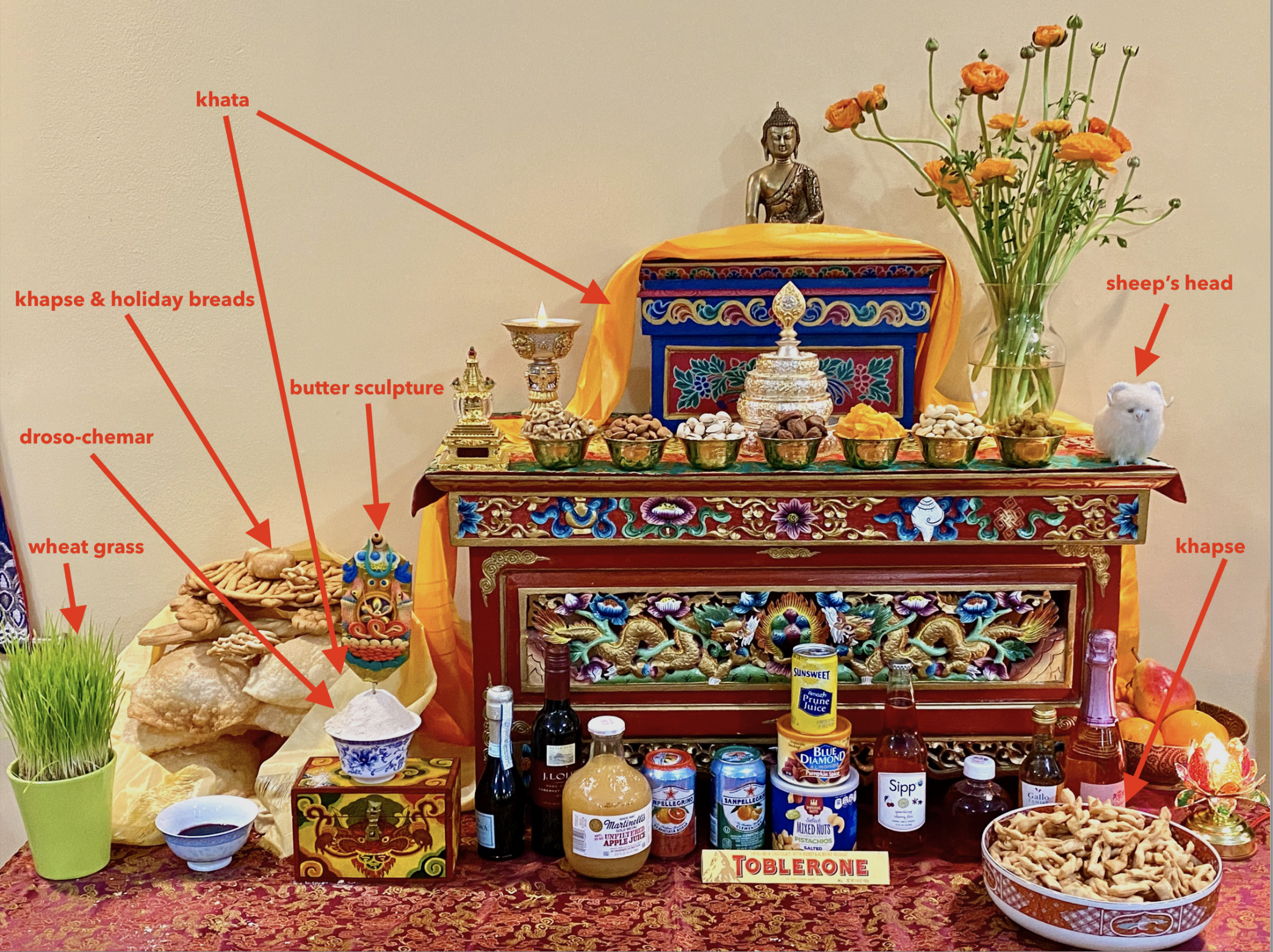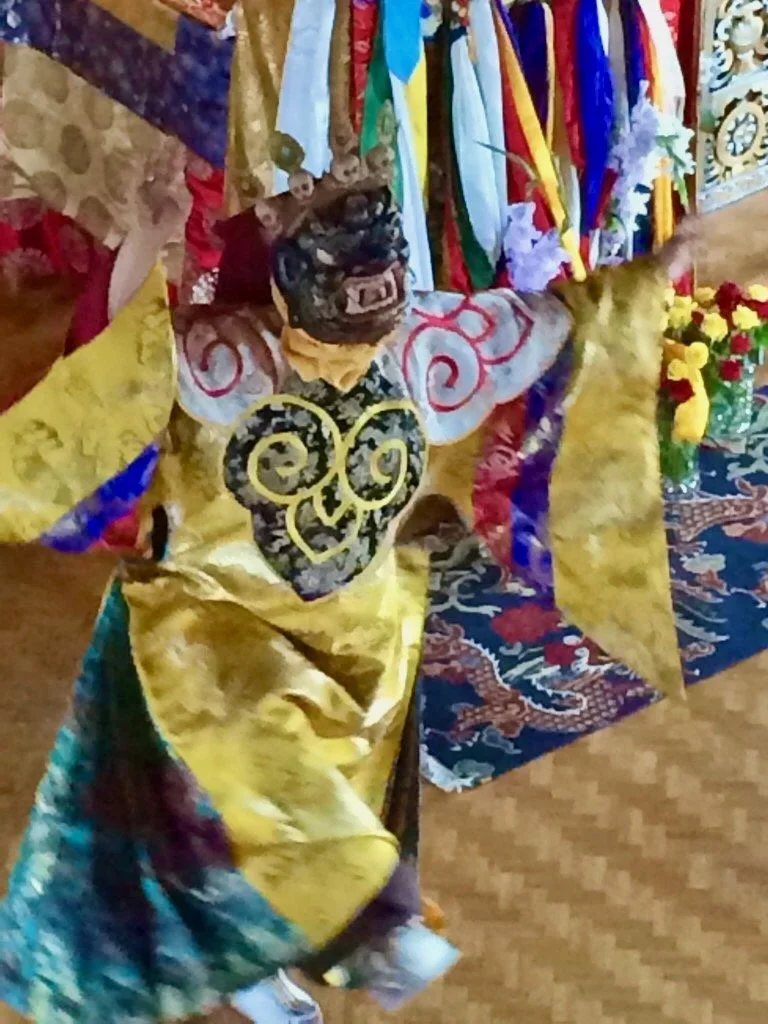Celebrating Losar: the Tibetan New Year
March 3rd, the first day of the new moon is the day that we celebrate Losar this year. Losar is the Tibetan celebration of the new lunar year. Lo means “year” and sar means “new” or “fresh.” Just as the solar cycle starts on January 1, the lunar cycle starts anew in February or March, depending on the lunar calendar and region. This year, Chinese New Year was February 2nd. It is not unusual for the Tibetan New Year and Chinese New Year to be celebrated at different times.
Losar altar in the shrine room of Sukhasiddhi Foundation before the pandemic
Preparation for Losar can start as much as a month beforehand. The days immediately preceding Losar are focused on cleaning, purification, preparing many offerings in various forms, and invoking the wisdom protectors. This is a time to deep clean one’s home preparing for the newness of the new year, purification and removing obstacles. It is a time for donating unused items to those in need. Traditionally, new clothes are made to wear during the Losar celebration.
Specials altars are often created for Losar, so the days leading up to Losar will frequently include baking traditional bread and cookies for the altar and to give as gifts.
On Losar, we expand our daily altar to include abundant food offerings and auspicious items. Creating the altar and its offerings is a practice of devotion and open-hearted generosity. It sets the tone for further developing those qualities during the new year and generates momentum towards awakening. Items that are added to one’s daily altar for Losar include:
An ornate ceremonial box called a droso-chemar (Wylie: gro so phye mar) or 2 bowls that hold 2 piles of grain, one of chemar (roasted barley flour, butter, and sugar) and one of roasted barley or wheat. When friends and family visit your home on Losar, they take some of the grain offering, make a blessing and aspiration as they toss the grain in the air and then take a small bite.
Ornate offerings made of butter or other moldable substances are created and placed on the altar. Sometimes these are painted. Traditionally, one is placed vertically in the droso-chemar.
Fresh wheat grass representing the freshness of the new year
A representation of a sheep’s head is traditionally placed on the altar. In the nomadic culture of Tibet, this symbolizes health and abundance.
Abundant food and drink offerings are made:
Deep-fried cookies called khapse in various shapes and sizes are piled high on the altar.
Decorative sweet treats and candy
Fruit: both fresh and dried
Cookies
Sweetened rice: rice (cooked with less water than usual), butter, sugar, saffron water, raisins
nuts
Fresh, beautiful flowers
Tea
Incense
Khata
Just as the devotional generosity of offerings sets the tone for the new year, so do all our activities around the time of Losar. It is important to easefully act with intention while embodying the 6 paramitas (generosity, morality, patience, enthusiastic diligence, concentration, wisdom). We engage in this way during the time of Losar with as a way of making the intention to align ourselves with the dharma and our buddha nature in the next year.
The traditional invoking of the wisdom protectors takes the form of multiple days of protector practices/pujas in the days leading up to Losar. Losar is a time of paying respect to one’s teachers, the lineage, and benefactors. It is a time of making offerings to your spiritual home as well as other meditation centers and monasteries. It is a time of joyous celebration with family, friends, and one’s spiritual community.
At home, you can prepare for Losar by deep cleaning your home or at least cleaning your altar on March 1st (the 29th lunar day). Once your altar is clean, you can expand your offerings to include any of the above items. Gather the items that you would like to offer and take time to reflect on the benefit you have received from the dharma, the lineage, your teachers, and your sangha. Reflect on what makes your current human birth a precious blessing and opportunity to awaken, and reflect on your aspiration to awaken not just for yourself, but for all beings. With open-hearted generosity, place various offerings on your altar. Make prayers and aspirations for the new year.
On the day of Losar (March 3rd), you can support the freshness of the new year by wearing something that is new. You can light new candles on your altar, offer a khata to the altar and recite a refuge prayer and generate bodhicitta. Then, spend some time in meditation, including Chenrezig or Tara practice. It is always beneficial to end your practice with reciting some aspiration prayers and it is especially beneficial to do that on Losar. Spend the day enjoying time with family and friends in a way that reflects how you wish to experience in the coming year.
This new lunar year is the year of the Water Tiger. It is a time of courage, strength and overcoming obstacles in a manner that is kind, conscious, communicative, and intuitively attuned to the situation at hand. Given the many challenges of the past year and those before, this is welcomed medicine.
May all your actions of body, speech, and mind bring you more and more into alignment with the dharma and your buddha nature as we cross the threshold into the new year and traverse the new lunar cycle!


